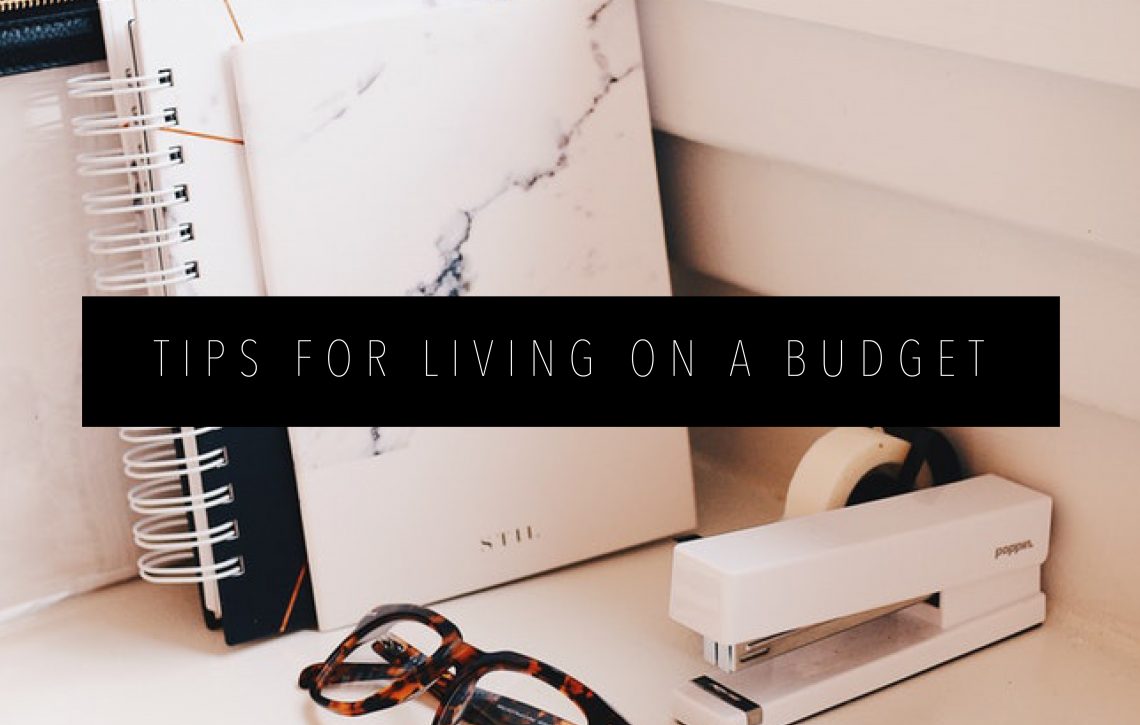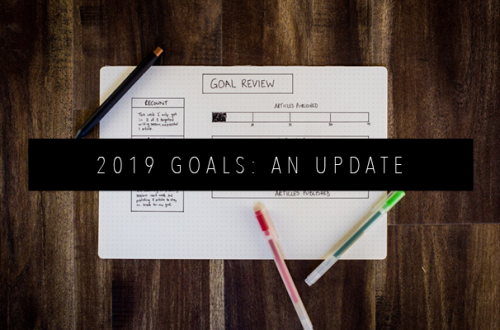Living on a budget is one of the hardest things about being an adult. Figuring out what your budget needs to be and understanding how to allocate your funds can be difficult, but it’s so important to living a sustainable life. I used to think I was broke in college, but I didn’t know broke until moving out on my own to Nashville, TN. I also feel obligated to mention that there is a huge difference between being broke and being poor. This video by The Financial Diet outlines those difference perfectly. While I may not be able to afford a trip to Europe, I can afford to put food on my table and live in a nice apartment.
I started budgeting when I switched jobs. I was making significantly more money at a different job, and when I switched, I needed to start budgeting more strictly to live within my means. The number one rule of living on a budget is to live within your means. Don’t pay off one credit card with another credit card. Don’t only pay the minimum on your credit card balance every month and let your interest build up. Live your life, but live within your means. I’ve got Pottery Barn taste on a Target budget, so I know how hard it can be to stay on budget, but for me, staying within my budget saves me a lot of worrying and anxiety because I know I have plenty in my savings account if anything were to happen.
It can be hard to create a budget if you don’t know what your living expenses are like, so before setting strict budgets for yourself, I recommend tracking your spending for a few months to take note of any spending patterns — figure out where you are spending your money, where you can cut down on spending if you have to, and where you can start saving.
I’m by no means a Master of Budgeting, but I have a good beginner’s idea on how to create a budget and how to stay within in. Let’s get started!

1. Create a budget.
The number one step to living on a budget is having a budget to live on. I’m fortunate enough to have people around me that are incredibly good with money (my dad is a CPA and my best friend works in finance), and who are always willing to help me better allocate my money. The simple way to start a budget is to start with the 50-30-20 rule. This “rule” states that 50 percent of your earnings should go toward your fixed expenses (non-discretionary money — money that goes towards your needs, like rent, food, car insurance, etc.), 30 percent of your earnings should go toward your discretionary expenses (eating out, going to the movies, etc.), and 20 percent of your earning should go into savings (a straight savings fund or an IRA/401k).
2. Find free, fun events to go to with friends.
In a sense, I’m really lucky to be living in a big city. While it can get expensive at times, there are also so many free, fun events going on around me, especially in the summer, that its easy to find something free or low cost to do. Some of my favorite free/low-cost events to attend are movies in the park, farmer’s markets, art festivals, and free concerts. You can also do things like picnics in the park, walks around the city, or coffee dates at local shops to spend time with friends but not break the bank.
3. Be open about your financial situation with close friends.
I’m really open about my financial situation — possibly a little too open, I’m sorry — but it’s better for friends to know your situation than wonder why you’re always saying no to nights out on the town. You don’t need to give them the breakdown of your budget, but telling them you’d love to spend time with them, you just can’t afford expensive nights out every weekend is perfectly fine. While it’s important for friends to respect your financial situation, it’s also important for you to respect theirs. If they can afford to go to more events/activities than you, you just have to accept that. I’m not saying it’s going to be easy, but it will be worth it when you can sleep without having nightmares about your credit card bill stalking you.
4. Utilize budgeting applications.
Every budgeting app essentially does that same thing — so anyone that tells you you need to use THIS app is just really comfortable with that app, which is fine. My favorite app is Mint, but it does exactly the same thing as Every Dollar and You Need a Budget, so feel free to pick whichever platform fits your needs best. With Mint, I set up an initial budget when I first moved, and then started tracking my spending. Sometimes I need to reassign my spending (for example, all my Target purchases are inputed as “Home Supplies” when they are really “Groceries”) but I’m in such a habit of checking the app that it really doesn’t bother me. Budgeting apps are great because you can just link your credit cards to them and they do all the work. Mint shows me a breakdown of my spending by line item, category, and overall measures.
5. Allow for miscellaneous spending.
Miscellaneous spending might be my biggest spending category aside from my rent. This is where I throw everything that isn’t a common expense and I don’t budget for, like Lyft rides, household items that need to be restocked, gifts for friends birthdays, etc. You can’t budget for every little thing, but creating this category means you know you’re going to have some wonky spending habits. The most important thing is to know what you’re spending your money on.
6. Thrift shop!
I’m going to admit that I’m not the best at thrift shopping because I don’t have the patience for it, but if you’re someone who likes to shop, I definitely recommend thrifting. I’ve known tons of people who have found hidden gems at Goodwill or local thrift shops — I just never have that kind of luck. Thrifting can also be really fun if you like to don unique pieces. For thrifting inspiration, check out Girlboss on Netflix, the original thrifter!
7. Pack a lunch.
Food gets me every time. American culture revolves around food and eating out. I’m in the “making friends” stage of my life in Nashville, and the easiest way to make friends is to go out for dinner or drinks. Since I know I need to allocate some money toward social food adventures, and I also know that sometimes on Sundays I really just don’t feel like cooking, I try to meal prep for all my lunches during the week. This can be hard since some of my co-workers really like to eat out, but I’ve gotten pretty good at saying no and just enjoying whatever I’ve packed for the day. It saves at least $50 a week if you account for about a $10 per meal.
8. Evaluate non-essential spending, and see where you can cut.
This is something I participate in regularly. At the end of every month, I record all my expenses in an Excel document (using what I tracked with Mint throughout the month) and see where I may be spending too much. Whenever I make a non-essential purchase (clothing, makeup, etc.), I also calculate how many hours of work the item would equate to and if it’s really worth that to me. That might sound crazy, but it’s a great way to think about how you’re spending your money. When you’re earning it yourself, you want to spend it on things you really want/need. I’d also rather spend my money on experiences than things, so I remind myself of that when I’m making non-essential purchases. I did a month-long challenge of not shopping for any new clothes back in March, and you’d be surprised how much money I have saved since then.
9. Utilize reward programs.
I eat, live, breath Target. It’s where I get 80 percent of my clothes, it’s where I grocery shop, it’s where I buy home decor — basically, if I can get it at Target, I probably do. This is great for my wallet because Target is pretty affordable, and I also really love the style so it works out for me. Since I do a chunk of my monthly spending at Target, it made complete sense for me to sign up for a Target RedCard. I save 5 percent every time I shop. Every time. It also doesn’t cost me a dime to have the card as long as I pay off my balance every month, which I am religious about doing. I’m not saying you need to get a Target RedCard, but if you find a place you’re going frequently (Starbucks, Harris Teeter, etc.), and they have a reasonable rewards program (you don’t need to pay for it), there’s no reason NOT to sign up for it. Also, look into rewards programs like Ebates. Ebates is an online reward program — basically any time you shop, you get money back. While I don’t do a ton of online shopping, I’ve already earned money through Ebates. The important thing is to buy what you need while utilizing the reward program — don’t shop because you’ll get money back, shop because you actually need whatever you’re buying.
10. Reward yourself.
I live my life on a pretty strict budget (in my opinion), but that doesn’t mean I stop myself from buying everything fun. If I haven’t eaten out in a week, I usually treat myself to either Panera or Chipotle on a Sunday. If I stay under my budget for the month, I treat myself to a movie. And if I go an entire month without buying a new clothing item, I’ll treat myself to a new dress (which usually only costs me $20 at Target). It’s important to stay in budget and pay off credit cards, loans, and debts, but it’s also important to Treat Yo Self every once in a while.
While I don’t think I’ve got this budgeting thing completely down, I know I get better at it every single month. Budgeting is hard. Adulting (sorry to everyone that hates people that use “adulting” as a verb) is hard. But we’ve got to do it. Let me know your budgeting tips in the comments below!
Happy budgeting,
Kimberly







54 Comments
central london harley street addiction counsellor
Thanks for sharing, this is a fantastic article post.Much thanks again. Fantastic.
sieunhanden
Your article is really useful to me, thank you very much.
unblocked games stick war 2
Viettokuda
Great books, thank you for posting.
fishing games free online
futbol.run Under-21 2011 - History - Switzerland-Georgia
Sami Nasri has revealed he will be out for a further three months with the hamstring injury picked up against Bournemouth back in October. The midfielder suffered the issue against Bournemouth. Manchester City star Samir Nasri faces three month injury lay-off but promises to return to action even stronger
descargar facebook
Appreciate this post. Will try it out.
sling tv coupons and promo codes for november 2018
Sling tv coupons and promo codes for november 2018
Hello, I think your blog might be having browser compatibility issues.
When I look at your blog site in Ie, it looks fine but when opening
in Internet Explorer, it has some overlapping. I just
wanted to give you a quick heads up! Other
then that, excellent blog! Sling tv coupons and promo codes
for november 2018
What Equipment is Needed for Sling TV
Thank you for the auspicious writeup. It in fact was a amusement account it.
Look advanced to far added agreeable from you! By the way, how could we communicate?
Chu
Today, I went to the beaxh front with my children. I found
a sea shell and gave it to my 4 year old daughter andd ssid
“You can hear the ocean if you put this to your ear.” She placed the
shell to her ear and screamed. There was a hermit crab inside and it pinched
her ear. She never wants to go back! LoL I knoow this is entirely offf tkpic but I had to tell someone!
What Equipment is Needed for Sling TV
Please let me know if you’re looking for a writer for your blog.
You have some really great posts and I feel I would be a
good asset. If you ever want to take some of the load off, I’d love to write
some material for your blog in exchange for
a link back to mine. Please shoot me an e-mail if interested.
Regards!
Quest Bars Cheap
I’m gone to convey my little brother, that he should also pay a quick visit this
web site on regular basis to take updated from newest news.
quest bars
I know this website provides quality depending content and other information, is there any other site which
presents these kinds of things in quality?
Quest Protein Bars
Hi! I simply wish to offer you a big thumbs up for the
great info you’ve got here on this post. I am returning to your website for more soon.
Football Solutions Women's World Cup - Matches
New MLS expansion franchise Los Angeles FC are eyeing a Premier League raid ahead of their inaugural season. The club plans to enter the MLS for the start of the 2018 season Los Angeles FC target Premier League signings ahead expansion franchise’s first season in the MLS
quest bars cheap
Quest bars cheap fitnesstipsnew1 quest bars cheap 516999410492780544 quest bars cheap
I loved as much as you’ll receive carried out right here.
The sketch is attractive, your authored subject matter stylish.
nonetheless, you command get got an impatience over that you wish be delivering the following.
unwell unquestionably come more formerly again since exactly
the same nearly a lot often inside case you shield this increase.
Quest bars cheap fitnesstipsnew1 quest bars cheap
516999410492780544 quest bars cheap
quest bars cheap
Your mode of describing everything in this piece
of writing is in fact fastidious, every one can without difficulty
know it, Thanks a lot.
descargar facebook
Thank you for the good writeup. It in fact was a amusement account it.
Look advanced to more added agreeable from you!
By the way, how can we communicate?
http://twitter.com/descargar_hq
Descargar facebook
great publish, very informative. I wonder why the opposite experts of this sector
don’t notice this. You should proceed your writing.
I’m confident, you have a great readers’ base already!
Descargar facebook
Health Benefits of Coconut Oil
Hi, this weekend is pleasant designed for me, since this point
in time i am reading this wonderful educational
post here at my residence.
Health Benefits of Coconut Oil
Hi there! I simply want to give you a huge thumbs up for your excellent info you have right
here on this post. I’ll be coming back to your website for
more soon.
Health Benefits of Coconut Oil
I don’t even know how I ended up here, but I thought this post was great.
I don’t know who you are but definitely you’re going to a famous blogger if you aren’t already 😉
Cheers!
Coconut Oil Benefits
Hi there! Someone in my Facebook group shared this website with us so I came to check it out.
I’m definitely enjoying the information. I’m bookmarking and will be tweeting this to my followers!
Superb blog and superb design.
Coconut Oil Benefits
It’s the best time to make some plans for the longer term and it is time to be happy.
I have read this post and if I may just I want to
suggest you some fascinating issues or suggestions. Maybe you could write subsequent articles
relating to this article. I wish to read more things about it!
醫學美容 炎之妥 cosmetic.wiki
NRK essential 【身體保養】玻尿酸美白保濕護手霜 HA Brightening & Hydrating Hand Cream的商品介紹 NRK essential,身體保養,玻尿酸美白保濕護手霜 HA Brightening & Hydrating Hand Cream
Benefits of Coconut Oil
I could not refrain from commenting. Well written!
minecraft secret free download
Hello, i think that i noticed you visited my weblog thus i came to return the
favor?.I am trying to find things to improve my website!I suppose its ok to make use of some
of your ideas!!
醫學美容 手霜 cosmetic.wiki
Les Merveilleuses LADUREE 【Cheek】浮飾仕女頰彩(星象限定版)的商品介紹 UrCosme (@cosme TAIWAN) 商品資訊 Les Merveilleuses LADUREE,Cheek,浮飾仕女頰彩(星象限定版),有網友推薦最新1
tinder dating site
I’m not that much of a online reader to be honest but your
sites really nice, keep it up! I’ll go ahead and bookmark your
site to come back down the road. All the best
痘疤
讓角質層充滿明亮濃密滋潤,確實迎向淨透白皙,實現水潤透亮的彈力肌膚。
Wealth Link Credit 富通信貸 » 專業信貸
除一般大型屋苑外,村屋、丁屋、唐樓、附有租約之物業、車位、工商樓宇及舖位等均接受按揭申請,亦接受高樓齡物業的按揭申請。
minecraft free download 2018
Hello to every body, it’s my first pay a visit of this webpage;
this weblog includes awesome and really fine stuff designed for readers.
minecraft free download 2018
I really like your blog.. very nice colors & theme.
Did you create this website yourself or did you hire someone to do
it for you? Plz reply as I’m looking to construct my own blog and would like to find out where u got this from.
thanks a lot
minecraft
My partner and I stumbled over here by a different web address and
thought I may as well check things out. I like what I see so i am just following
you. Look forward to looking over your web page again.
minecraft
Awesome issues here. I’m very happy to peer
your post. Thanks so much and I’m looking ahead to touch you.
Will you please drop me a mail?
minecraft
Wonderful article! We will be linking to this particularly great content on our website.
Keep up the great writing.
minecraft
I’m really inspired along with your writing talents and
also with the layout on your blog. Is that
this a paid theme or did you customize it
your self? Anyway keep up the nice quality writing, it’s uncommon to see
a nice weblog like this one today..
ปั้มไลค์
Perfectly composed articles , thankyou for information. 🙂
minecraft
Hello There. I found your blog using msn. This is a really well written article.
I will be sure to bookmark it and return to read more of your useful info.
Thanks for the post. I’ll definitely comeback.
minecraft
Stunning quest there. What happened after? Thanks!
minecraft
Hello! This is my first comment here so I just wanted to give a quick shout out and say I genuinely enjoy reading your posts.
Can you recommend any other blogs/websites/forums that cover the same topics?
Thank you so much!
minecraft
Thank you for sharing your info. I really appreciate your efforts
and I am waiting for your further post thanks once again.
minecraft
Wow that was unusual. I just wrote an incredibly long comment but after I clicked submit my comment didn’t show up.
Grrrr… well I’m not writing all that over again. Anyway,
just wanted to say superb blog!
minecraft
Quality posts is the important to attract the users to pay a
quick visit the web site, that’s what this web site is providing.
minecraft
I do believe all the concepts you’ve offered on your post.
They’re really convincing and will certainly work.
Still, the posts are too quick for beginners.
May just you please prolong them a little from subsequent time?
Thanks for the post.
minecraft
Great article, just what I was looking for.
minecraft
Hi would you mind letting me know which web host you’re working with?
I’ve loaded your blog in 3 completely different internet browsers and
I must say this blog loads a lot faster then most. Can you
suggest a good hosting provider at a honest price?
Thank you, I appreciate it!
minecraft
Asking questions are genuinely good thing if you are not understanding anything fully, but this
article presents good understanding yet.
minecraft
May I simply say what a comfort to discover a person that truly knows
what they are talking about over the internet.
You definitely understand how to bring a problem to light and make it important.
A lot more people must check this out and understand this
side of your story. I was surprised that you aren’t more popular because
you certainly possess the gift.
minecraft
Hi, this weekend is nice in favor of me, because this point in time
i am reading this impressive educational post here at my
residence.
minecraft
My partner and I stumbled over here by a different
website and thought I might as well check things out.
I like what I see so now i’m following you. Look forward to looking
over your web page for a second time.
minecraft
Hi there! This post could not be written any better!
Reading through this post reminds me of my previous room mate!
He always kept talking about this. I will forward this page to him.
Pretty sure he will have a good read. Thanks for sharing!
minecraft
It’s great that you are getting thoughts from this paragraph as well as from our dialogue made here.
minecraft
Aw, this was an extremely nice post. Taking the time and actual effort to produce
a superb article… but what can I say… I hesitate a lot and
never seem to get nearly anything done.
ปั้มไลค์เพจ
It is in reality a great and useful piece of info. Thanks for sharing. 🙂
Like
Like!! I blog quite often and I genuinely thank you for your information. The article has truly peaked my interest.